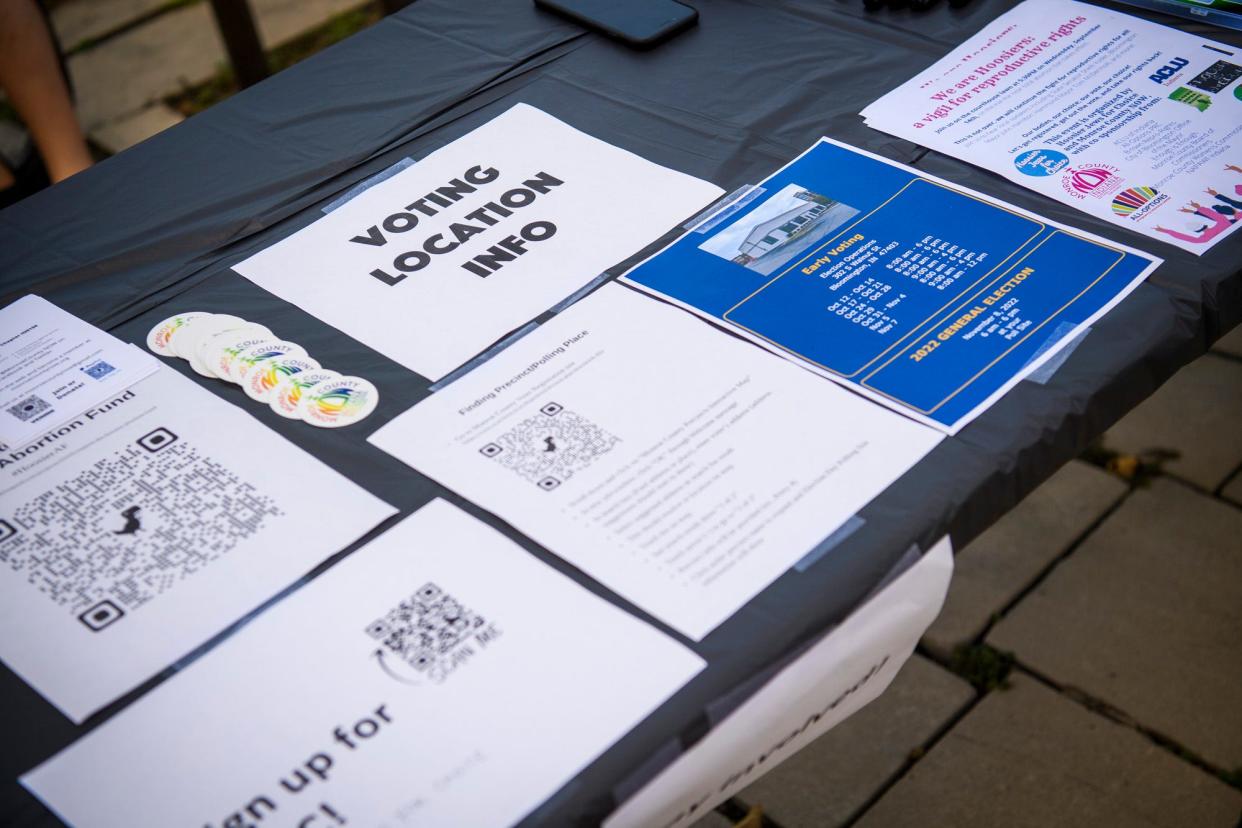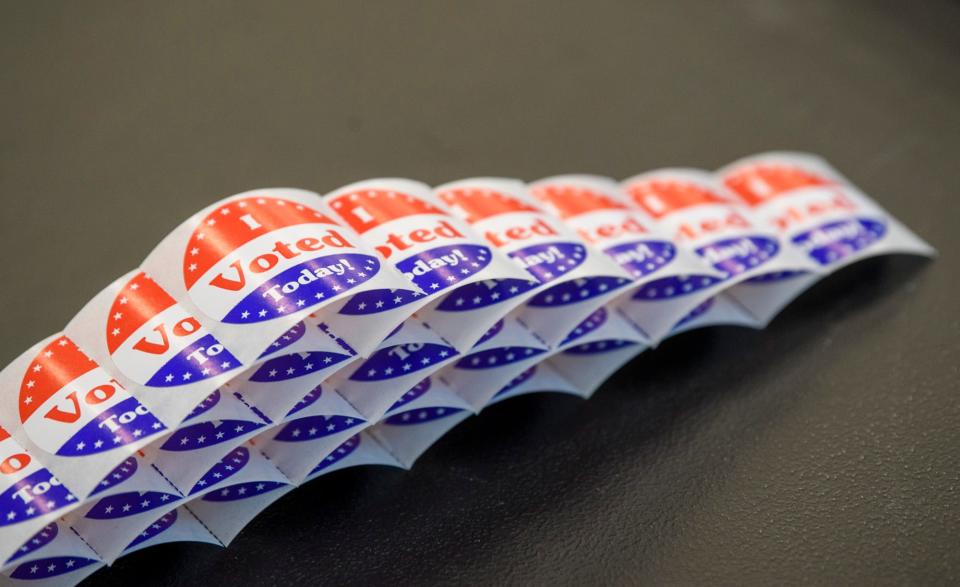Will Indiana's near total abortion ban motivate college students to vote?

One day before Indiana's controversial legislation restricting people's eligibility and access to abortions was to take effect, a hundred people gathered at the Monroe County Courthouse for an abortion rights vigil. Some keynote speakers spoke of their sadness and exhaustion over the news. Others spoke with fervor and fire in their voice, demanding a change. But in all the speeches, they shared one clear message: Everyone needs to register to vote.
Semhar Araya, vice president of Indiana University's chapter of the NAACP and a keynote speaker at the vigil, spoke about how an effective way to use your voice in the United States is to participate in local elections.
FOR SUBSCRIBERS:Monroe County judge will decide if Indiana's new anti-abortion law will stand
"Don't let this be the end of our fight," Araya said. "We know that we need representation. I feel like we do not have representatives that represented what we think."
Do college students vote?
Historically, college students have been notably absent at polling locations across the nation. This is especially ironic for those enrolled at Indiana University's Bloomington campus, given the size of the student population, according to IU student David Wolfe Bender.
"Right now, we're not in the room. There is no student on the city council. There are very few students serving on boards and commissions. Right now, in our city, decisions are not being made by us, despite the fact that half of our city's population is made up of IU students," Wolfe Bender said.
Some people have argued students' significant lack of voting effort leads to less candidates whose platforms align with those students' values getting elected.
Indiana abortion law:Mourning the dawn of new restrictions, protesters gather at Monroe County Courthouse
"Democracies are not self-sustaining. The people who live in them have to sustain them," IU emeritus professor of political science Marjorie Hershey explained. "There's been too much effort and too many lives over time to risk having this democracy fade away because of inattention and lack of vigilance."

Bloomington college students don't turn out in the polls, are less represented
While young people bear the stereotype of not participating in elections nationwide, college students still can be motivated to show up at the polls. In the 2020 general election, IU student turnout increased by nearly 22% from 2016, going beyond the 13% increase seen on universities nationwide. However, given that 2020 was a presidential election, it is more likely an exception than the new norm.
That notion seems to be backed up by local turnout in the May primary elections. The Bloomington 7 precinct, which covers a campus dormitory and many greek houses, has around 1,200 registered voters. Despite this, only three people voted there during the 2022 primary election. At the Bloomington 5 precinct, which covers many dorms including Wright Quad, only 15 voters showed up to the polls.
"We have got to do better," Natalia Galvan, president of Monroe County's chapter of the National Organization for Women, said.
Column:Despite pandemic, IU student voting shattered records in 2020
Monroe County NOW has partnered with several local organizations, including both IU and Monroe County chapters of the NAACP, IU Student Government and others, in a new campaign titled, "Vote where you sleep," which will try to reach and resonate with Bloomington's younger residents.
"A lot of students here are either not from Indiana or not from Bloomington, and a lot of people don't understand the value of voting locally," Galvan said. "So not only are we trying to get them to register to vote, but we're trying to get them to understand that they're not temporary residents. They're full-time residents."
Wolfe Bender, IU Student Government’s director of city relations, noted students should have more of a presence in town as one of the largest population sects in Bloomington.
"I encourage students to really think about the fact that they spend most of their time here in Bloomington. Bloomington is their home for the next four years. Their daily life is really affected by the policies that we see enacted at the local city, county and state level," Wolfe Bender said. "I think if students put a little bit more thought into how their daily lives look, then they might see how those tangible city policies could really matter to them."
Wolfe Bender gives the examples of public transportation, street design and upkeep, and housing affordability as key issues that students should have a vested interest in having their perspective heard.
Campaign organizers say they will try to reach students on and off campus by partnering with other student organizations and nearby businesses, such as those on Kirkwood Avenue, to host signage urging people to vote.
According to Galvan, the posters will have QR codes that link to voter education materials. Galvan said they also have an early partnership with Bloomington Transit that will secure micro-transit methods for people to be driven to their polling location. Galvan and Wolfe Bender both noted their organizations will participate in many upcoming events to meet students where they already are. They hope this campaign will inspire students to vote locally.
Megan Huey fits the demographic of this campaign's intended audience. She's a freshman at IU who hails from Missouri. She voted for the first time with her mom in the spring primary election at St. Louis. Though she lives in Indiana as a college student now, she planned to vote in Missouri via absentee ballot.
While noting abortion rights as one of her main issues of concern, she describes how Missouri is facing similar restrictions as Indiana. Current Missouri law outlaws abortion except in medical emergencies or when it's necessary to save the mother's life. Because she is more familiar with Missouri policymakers than Indiana's, Huey feels more connected to the legislation in her home state than her current residence.
Since Indiana's Senate Bill 1, which banned abortions except in certain exceptions, Galvan noted she's seen a lot of college students becoming more engaged in local politics. But even if students do turn out and show up in droves to the polls, their impact might be undercut by recent partisan-led redistricting efforts.
Statehouse is 'rigging' the election. Here's why your vote still matters
Every 10 years, shortly following the census, U.S. states redraw boundaries of political districts in an effort to account for population shifts. While some states have their boundaries are drawn by independent commissions, most states, such as Indiana, have the maps drawn by the political party controlling the Statehouse.
More:'The fix is in': Sharp criticism for GOP redistricting in Indiana, Bloomington
Both political parties typically redraw their maps in order to weaken the power of their opposing party's voter pool. This common political tactic is known as gerrymandering, "which lets candidates choose their voters, rather than letting voters choose their candidates," Hershey said.
"The partisan representatives want to help their party win. The best way you can do that is by rigging elections in advance, so that the districts are drawn in ways that favors electing your own party's candidates," Hershey said.
There are two common methods of gerrymandering: packing and cracking.
For the past 10 years, Indiana's Republican majority leaders "cracked" Monroe County, slicing it into several districts in the hope that the voters of the Democratic Party would be outnumbered by Republican voters.
With this recent census, the state's Republican majority packed Bloomington into a small, tight district. In a "packed" district, the leaders try to squeeze as many voters of the other party as possible into one district. While the minority party will win one district by a much bigger percentage (such as 85%) than it needs, it limits the minority party's votes in surrounding districts.
"That's satisfying, but it's a bad idea because it ended up with about 30% more voters voting for it than it needed," Hershey said. "If it could take those 30% other voters and scatter them into the other districts around, those other districts might be more competitive."
According to an analysis by Princeton University, Indiana has no competitive districts for U.S. Congress. Election forecaster FiveThirtyEight calculates that for the two U.S. House seats Indiana Democrats hold, they have a 91% and 97% chance of holding on to them; Republicans’ likelihood of holding on to their seven seats ranges between 94% and more than 99%.
"If you can control the rules, you can control the outcome," Hershey said. "The rules come first. Everything else comes after that. As a result, a lot of people who are dissatisfied with politics now need to be aware of what the rules are that cause those policies."
According to Hershey, eligible voters should not be disillusioned by the current system set in place. Instead, they should be more active in making their voices heard.
"The best possible way to silence (someone) is to keep telling them 'Your vote doesn't count,'" Hershey said. "Granted, they have a lot of the cards in their hand, but they don't have all of them."
A change in how policies are adopted can have surprising results. In Kansas, a state with a Republican-controlled legislature and deep ties to the anti-abortion movement, voters were allowed to weigh in on whether to accept a ballot measure that would extremely tighten or outright ban the abortion procedure. In an unexpected move, voters rejected the ballot measure, protecting abortion rights in the state.
"It failed because of students turning out to vote. The students at their major state universities said that this is not appropriate. And they stood up and they showed up and they made their voices heard and abortion is going to be protected in Kansas for the time being," Wolfe Bender said.
More:Bloomington family fights for transgender daughter amid bill banning her from girls' sports
Being informed about how to vote and how your vote can be best utilized is important, Hershey emphasized.
"It's important for people to realize that they have to figure out why is it that all these states that seem to have our pro-choice majority are passing anti-abortion laws. Well, it has to do with gerrymandering. It has to do with the turnout in primaries. It has to do with whether or not the state legislative election in your district has candidates from both parties, or just candidates from the dominant party," Hershey said. "Once you've figured that out, then you've got to act."
How to vote in Indiana: Registration deadlines, methods
To register in Indiana, a person must be a U.S. citizen, at least 18 years old and have lived in the voting precinct at least 30 days before the election.
You can register to vote by mail or in person, or online at indianavoters.in.gov. Residents can visit or mail the completed form to Monroe County’s voter registration office or the Indiana Election Division. The deadline to register is Tuesday, Oct. 11. If you are unsure whether you are registered to vote, you can check your status at indianavoters.in.gov.
IU students have access to a separate portal at IU.TurboVote.org, which allows them to easily register to vote, update their voter registration and sign up for automatic notifications to alert them via text messaging when the polls open.
Rachel Smith covers Indiana University and student life for The Herald-Times. Reach her at rksmith@heraldt.com or on Twitter @RachelSmithNews.
This article originally appeared on The Herald-Times: After Indiana passes abortion ban, college students urged to vote

